Darwin Centre, Natural History Museum London, Architect, Architecture, Pictures
Darwin Centre London – Cocoon
Phase 2 Natural History Museum Building, London, England, UK
14 Sep 2009
Darwin Centre
Natural History Museum unveils the Darwin Centre at royal celebrations
Design: C F Møller Architects
HRH Prince William of Wales and Sir David Attenborough herald new Darwin Centre as key to answering the great questions of the natural world
– unique new public gallery, showing the hidden scientific life of the Museum in a new, free London landmark that opens to the public on 15 September
– millions of plants and insects revealed in hub of world-class life sciences research
– nature-inspired opening celebrations attended by HRH Prince William of Wales, Sir David Attenborough and the Secretary of State for Culture, Media & Sport, the Rt Hon Ben Bradshaw MP
– major supporters include the Heritage Lottery Fund (£20.5m), the Department for Culture, Media and Sport (£10.7m) and the Wellcome Trust (£10m)
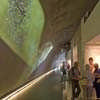
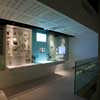
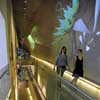
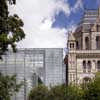
Darwin Centre photos © Natural History Museum
In his opening address to a gathering of over 300 guests, HRH Prince William of Wales said, ‘As the superb new facilities of the Darwin Centre show, the Natural History Museum and the dedicated people who work here are at the very forefront of research, seeking out through study of the natural world the answers to the great questions of our age.’
He concluded, ‘It is such a privilege for me to be asked here today to open the Darwin Centre. The Natural History Museum is one of our great institutions. Its collections, and what it achieves in the areas of research and education make it – quite simply – the envy of the world. This magnificent new wing will further enhance the museum’s peerless reputation.’
When it opens tomorrow, visitors will share the excitement of exploring, studying and preserving the world with leading scientists. Up to 2,500 people a day will travel deep into the eight-storey cocoon to see some of the Natural History Museum’s scientists in action, working in high-tech laboratories, preparing thousands of real specimens and working among 3.3 kilometres of cabinets that hold millions of plants and insects. Through a diverse daily programme of events, new public gallery and high-tech installations, visitors will have an uninhibited snapshot into these once concealed spaces at the Museum.
During what was Prince William’s first official opening at a museum, he helped a museum scientist working in a molecular lab, viewed some of the museum’s 20 million insect and plant specimens and met young patients visiting from The Royal Marsden Hospital as they enjoyed a science show in the centre’s high-tech, Attenborough Studio.
Sir David Attenborough, who also addressed guests, paid homage to the Natural History Museum’s ability to inspire and inform. He said, ‘Never has it been so important to understand the diversity of life on Earth and how it is changing, if we are to tackle many of the issues that humans face today. The Darwin Centre will inspire the next generation of naturalists and scientists through its combination of scientific expertise, specimens, public dialogue, film and interactive media. It will enable all of us to explore the wonders of our world and investigate its secrets.’
The landmark building project completes the Darwin Centre, the most significant development at the Museum since it moved to South Kensington in 1881. The first phase, housing the Museum’s 22 million zoological specimens stored in alcohol, opened in September 2002.
The Rt Hon Gordon Brown MP, Prime Minister said, ‘I am delighted to see this exciting new part of the Natural History Museum open its doors. We are absolutely committed to investment in science in this country and our ambition to deliver the next generation of world-class scientists. This innovative new centre, with its high-tech facilities and first-rate research is a fantastic example of this. The Darwin Centre is certain to engage the public on some of the great challenges facing our planet and inspire the young scientists of the future.’
£78M NEW DARWIN CENTRE BY
CF MOLLER ARCHITECTS OPENS AT THE NATURAL HISTORY MUSEUM
8 Sep 2009
The Natural History Museum is both one of the UK’s top five visitor attractions, and a world-leading science research centre. The architecture of both phases of the Darwin Centre are designed to reflect this dual role, and, through innovative and ambitious design, reveal to the public for the first time the incredible range and diversity of the Museum’s collections and the cutting-edge scientific research they support.
Neil Greenwood, the Natural History Museum’s Programme Director for the Darwin Centre, explains, ‘Many people love the Natural History Museum for its iconic Victorian Waterhouse building. However, through the Darwin Centre, we wanted to challenge this traditional perception and highlight the work of our scientists and the importance of our collections. The Darwin Centre is set to be a truly inspirational addition to the Natural History Museum when it opens to the public on 15 September 2009.’
The second phase of the Darwin Centre, designed by C F Møller Architects, completes the western site of the Natural History Museum, uniting Alfred Waterhouse’s terracotta construction from 1881, with the first phase of the Darwin Centre which opened in 2002. Like the rest of the Natural History Museum, the new completed Darwin Centre plays three important roles: safeguarding the millions of specimens in the Museum’s collections, providing research facilities for our scientists, and inspirational public spaces for visitors. It is these three uses that are central to the design of both phases of the Darwin Centre.
Darwin Centre : Second Phase
Designed by C F Møller Architects, the second phase of the Darwin Centre takes the form of a huge eight-storey concrete cocoon, surrounded by a glass atrium. This centrepiece resembles a large silk cocoon, and forms the inner protective element of the Darwin Centre’s second phase. The scale of the Cocoon is such that it cannot be seen in its entirety from any one position, emphasizing its massive scale. The shape and size give the visitor a tangible understanding of the volume of the collections contained within.
The collections areas within the Cocoon are world class, the regulation of temperature and humidity, as well as the separation of work and storage areas reduce the risk of pest infestations ensuring that the collections will be protected and preserved for many years to come.
Public access to the scientific core of the second phase of the Darwin Centre takes the form of a visitor route up and through the cocoon, overlooking the science and collection areas. This provides a complimentary activity to the Darwin Centre’s other function of protection, preservation and research. The visitor can experience the Darwin Centre as a compelling and interactive learning space, observing the scientific and research activities without interrupting scientific work in progress.
Anna Maria Indrio, partner at CF.Møller, comments “C. F. Møller Architects is very proud and honoured to have been given the task of designing a framework for the Natural History Museum’s unique collection of plants and insects. The large silk cocoon protected by a glass atrium encloses a fantastic treasure, reflecting evolution itself. The macroscale of the space and the size of the cocoon expresses the enormous importance of the collections. Iconic forms should only be used if the relationship between the building and its interpretation is entirely self-evident, as it is in this case.
The new building has completely changed the Natural History Museum’s relationship with the site from being an introvert to an extrovert building. It was incredibly demanding to solve the task of the second phase of the Darwin Centre in this way, but the cocoon will become a major attraction and a trademark of the Darwin Centre in the future.”
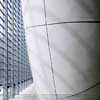
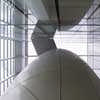
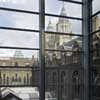
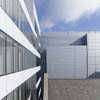
Darwin Centre photos © Natural History Museum
Darwin Centre : First Phase
Designed by HOK International, the first phase of the Darwin Centre houses 22 million zoology specimens preserved in jars of alcohol and provides state-of-the-art laboratories for 100 scientists.
The public areas of the first phase of the Darwin Centre, showcase the scale and diversity of this collection. Looking through a glass screen into the storerooms and up through the six-storey atrium visitors can appreciate the sheer volume of material kept there with illuminated floor-to-ceiling cases allowing a close-up view of specimens.
The collections themselves are kept in optimum storage conditions. Regulating the temperature of the storage rooms to a constant 13°C significantly reduces fire risks, and the separation of collections spaces from the work areas, and the placing of service systems outside of the building ensures that unnecessary access to the collections is minimised.
Darwin Centre : Second Phase in Numbers
· the second phase of the Darwin Centre has cost £78 million
· the base construction took around 25 months and 280 people to build
· at 60 metres long, 12 metres wide, 300 millimetres thick and 3,500 square metres, the eight-storey-high cocoon is the largest sprayed concrete, curved structure in Europe
· the cocoon will hold 17 million entomology specimens and three million botany specimens in 3.3 kilometres of cabinets
· these cabinets would stretch from the Natural History Museum in South Kensington to Westminster Cathedral if put end to end
· the cocoon is approximately 30 centimetres thick and will be kept at a steady 17°C and 45 per cent relative humidity, the optimum conditions to store collections
· the second phase of the Darwin Centre has 16,000 square metres of floor space
· the building will accommodate up to 220 staff and science visitors
· there will be 1,040 square metres of laboratory space, doubling the size of the Natural History Museum’s current laboratory areas
· 2,500 people per day will be able to take a self-guided journey through the collections and research areas
The second phase of the Darwin Centre is designed by Scandinavian architects CF Møller, who won an international architectural competition in 2001. It was built by BAM Construction Ltd.
Previously:
Darwin Centre Cocoon
Millions of plants and insects to emerge from eight-storey cocoon
Get ready to experience the Natural History Museum’s metamorphosis when the landmark new Darwin Centre opens to the public on 15 September 2009
The Natural History Museum will throw open the doors of the Darwin Centre to the public on 15 September 2009 and one of the highlights will be Cocoon, a journey deep into the 65-metre-long, eight-storey-high cocoon at the heart of the Darwin Centre. Here, you will discover some of the 20 million plants and insects protected by this enormous cocoon – from huge tarantulas to metre-high poisonous plants – and for the first time see into the hidden world of scientific research, where real Museum scientists work on cutting-edge research that could help protect the future of our planet.
Completed building photos

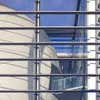
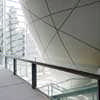
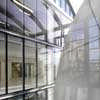
photographs : Torben Eskerod
Up to 2,500 people a day will travel through Cocoon to see some of the Darwin Centre’s 220 scientists in action working in high-tech laboratories, preparing thousands of real specimens or working amongst the 3.3km of cabinets that hold the millions of plants and insects. Through viewing decks, video and intercom, visitors will get an uninhibited snapshot into these once concealed spaces at the Museum.
Darwin Centre interior + exterior visualisations
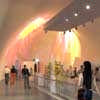
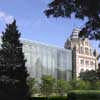
Darwin Centre Cocoon images © Natural History Museum
Entrance to the Darwin Centre will be free. Advance booking for timed slots opens today for visitors wanting to be among the first to experience Cocoon by calling 020 7942 5725 or visiting the Museum. Online booking is coming soon at www.nhmshop.co.uk
Scientists in action
Encounters with real scientists through Cocoon will give you insight into how Museum scientists travel to discover and name new species, prepare specimens and organise collections that are being used to help fight malaria or react to climate change:
” Decoding DNA – see into state-of-the art laboratories where scientists extract, process, sequence and analyse the DNA of plants and insects. One day you could be watching scientists working on mosquito material in their fight against malaria, and the next it could be bluebell DNA as scientists try to discover the origin of the British bluebell.
” Preparing specimens – in a unique opportunity to experience the life of a working museum scientist, a microphone in the dedicated specimen sorting area lets you talk directly to scientists about the work taking place that day.
They could be pressing plants collected from the streets of London or sorting through thousands of beetles fresh from the jungles of Central America.
” Looking closer – looking out of the cocoon into the The Sackler Biodiversity Imaging Laboratory, you will see scientific staff working with herbscan machines to create high-quality images of herbarium sheets to share with colleagues around the globe. You will be able to take a close-up look at beautiful microscopic plants and weird and wonderful animals using interactive installations.
Intro Table
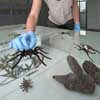
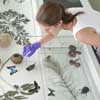
Darwin Centre Cocoon images © Natural History Museum
Diversity of life
The Natural History Museum has over 70 million plant, animal and mineral specimens in its collection. In the Darwin Centre alone, the cocoon will safeguard 17 million insect and three million plant specimens in world-class storage conditions. On your journey through Cocoon you will see more than 500 real insects and plants on display, including:
” 124 specimens in the introductory area including an Atlas moth with a 16cm wingspan, the 15.5cm elephant beetle and tiny 3mm sandflies on microscope slides
” a wall of 326 specimens over two floors, from a half-metre crayfish to a wingless termite
” around 50 giant plants including the 1.2m hemlock water dropwort Oenanthe crocata
” 20 historically important ‘iconic’ specimens, including the vegetable lamb of Tartary, insects collected by Darwin and Wallace and a bound herbarium volume containing plants gathered by the great collector Sir Hans Sloane
Dr Michael Dixon, Director of the Natural History Museum, comments, ‘For many years, hundreds of Natural History Museum scientists have been working behind the scenes to better understand our planet. Now, through the Darwin Centre, not only will our visitors really understand for the first time why the work of our scientists is so important, they will actually be able to interact with real specimens and real scientists, which we hope will really bring the experience to life for them. With so many issues facing the planet at this time, we hope that visitors will go away with a real sense of awe and wonder at nature, a better understanding of why the work of the Natural History Museum is so relevant, now more than ever, and be inspired to share in our collective responsibility over the future of the planet.’
In addition to real specimens and scientists, Cocoon will also feature over 40 high-tech installations and hands-on interactive activities that introduce you to many other Museum scientists, their work and its relevance to us all.
Cocoon is supported by GlaxoSmithKline and Anglo American. As leaders in their fields they support the Darwin Centre’s mission to promote the development of knowledge, understanding and skills that are needed to make sound decisions about the science-related issues we face everyday.
If you want to keep up to date with Darwin Centre developments ahead of the opening on 15 September and find out what’s on at the Museum, sign up now to our monthly enewsletter at www.nhm.ac.uk/enews
Darwin Centre visitor information
Dates: open from 15 Sep 2009
Opening times: every day, 10.00-17.50 (last admission to Cocoon 17.00)
Admission: free, to book timed tickets for Cocoon call 020 7942 5725
Nearest tube: South Kensington
Darwin Centre London design : C. F. Møller Architects
Location: Darwin Centre, London, England, UK
London Buildings
Contemporary London Architecture
London Architecture Designs – chronological list
Architecture Tours in London by e-architect
Darwin Centre : main page
Natural History Museum London Building
Lanesborough Hotel & Spa, Hyde Park Corner, Belgravia, Southwest London
Architecture: Filer & Cox ; Interiors: 1508
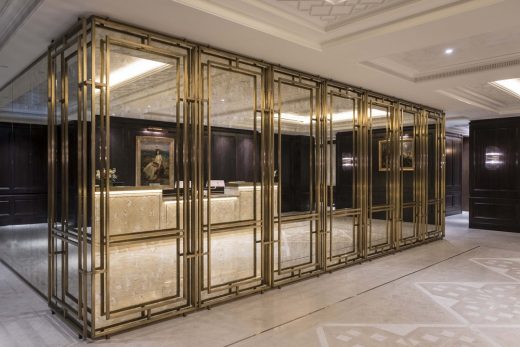
image from architects
Lanesborough Hotel & Spa
Taj Crowne Plaza London St James, 51 Buckingham Gate
Design: Broadway Malyan
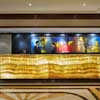
image from architects
Taj Crowne Plaza London St James
Natural History Museum Gallery by Ian Ritchie Architects
Comments / photos for the Darwin Centre Phase 2 Natural History Museum London page welcome
Website: www.nhm.ac.uk
